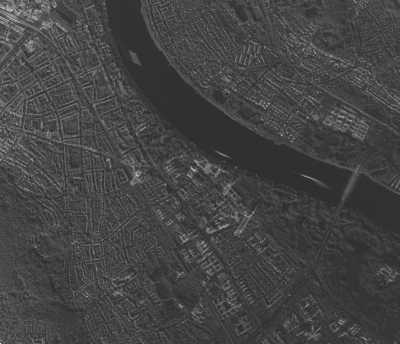- News & Events
- VHR Data Quality in the limeli...
VHR Data Quality in the limelight
08 Jun 2022
In recent years, the satellite landscape has steadily expanded with a variety of very high resolution (VHR) commercial satellites, also emerging from new space providers. A result of this growth is an increased need to address data quality assurance.
As the community of Earth observation (EO) data users gathered at the Living Planet Symposium (LPS) recently, there was a designated session on VHR data quality. Methodologies to ensure and monitor EO data quality were explored.
VHR data from ESA's Third Party mission (TPM) programme can be accessed for free by browsing the data collection pages on ESA's Earth Online portal.
Valentina Boccia, EO Data Quality and Calibration/Validation Manager for Optical Missions at ESA, who hosted the session, says, "Making sure the Earth observation data provided to our users worldwide are of high-quality is crucial. With large constellations of commercial satellites providing high-resolution and very-high-resolution data, this is becoming even more important.

"It's essential that users working with the ESA Third Party Missions have confidence in the data they use. ESA is playing a key role in setting up a common framework for quality assessment within the Earthnet Data Assessment Pilot (EDAP) programme and in promoting and facilitating discussions on the topic of data quality between the institutional space and the commercial new space sectors."
Standardised quality checks
The EDAP project is only a few years old but has become a key tool for assessing the quality and suitability of candidate missions being considered for ESA's TPM programme. The first phase of EDAP has just finished, under the leadership of Telespazio UK, who presented the outcomes at LPS.
Sebastien Saunier, VHR Optical Mission Calibration/Validation scientist at Telespazio UK, says, "New operational constellations of low cost VHR optical missions deliver sub metric spatial resolution images daily. However, in the new space arena, which targets application domains such as object detection, object recognition and tracking, the quality of the images is fundamental.
"While certain specifications are claimed by the missions, the actual quality of delivered images strongly depends on the satellite and data operator."
Saunier adds, "In the user community, there is an urgent need to adopt standardised methods and to rely as much as possible on calibration equipment (in-situ data) provided by space agencies.
The EDAP technical analysis proposes a standard method and forms a good basis to compare missions."
Smallsat SAR quality

Capella Space, with its constellation of high-resolution Synthetic Aperture Radar (SAR) small satellites, hopes to soon join ESA's TPM programme. As part of their TPM assessment process, Capella delivered a large SAR data stack for validation by EDAP in October 2021.
Capella was pleased to prove they have a low noise system with the Noise equivalent Sigma Nought calibration test, and that the geometric resolution and measured geolocation accuracy were in line with expectations.
SAR data quality improvement using innovative algorithms was further elaborated by a new member to the TPM programme, ICEYE, which provides a constellation of X-band SAR small satellites.
While the advantage of small SAR satellites are their minimal costs for improving revisit time, their azimuth ambiguity can put added demand on quality control. ICEYE presented techniques and algorithms to detect and suppress these ambiguities.
Agile automated checks
With over a million scenes and ortho products per day, Planet embraces the automation of data quality. Planet's PlanetScope and SkySat data have recently joined ESA's TPM programme.
Through ESA's Earthnet Programme, researchers, scientists, and companies can access Planet's high-frequency, high-resolution satellite data for non-commercial use.
While traditionally quality control was often achieved manually, Planet has now introduced some automated checks. There is a software team designated to quality control, Automated Quality Assurance (AQUA), which focuses on imagery geolocation accuracy. The list of technologies engaged by the team includes Google BIGQuery, Google Pub/Sub, Kubernetes, Terraform, Google Dataflow, Apache Airflow, Diango Rest Framework, and many more.
Matthias Kolbe, software engineering manager from the Planet team, says, "We found agile ways to assess the system for data quality, examining a range of geometric key performance indicators with absolute, temporal, scene-to-scene and band-to-band alignment.
In recent years the band-to-band alignment has improved significantly in Planet's VHR data, supported by this data quality process."
Following the morning session on data quality, there were a series of talks on the improvements in VHR data offerings from several TPMs: COSMO-SkyMed Second Generation provides improved VHR modes and quality, ICEYE SAR data enables persistent monitoring, WorldView-3 data facilitates methane emissions mapping, and the introduction of Vision-1 to the TPM Programme.
The decision to pioneer an LPS session on VHR data quality was certainly well received. Valentina Boccia concludes "ESA expects the discussions and dialogue with commercial data providers to continue at the VH-RODA workshop (Very High-resolution Radar & Optical Data Assessment) in November this year!"
The dates for the Very High-resolution Radar & Optical Data Assessment (VH-RODA) 2022 workshop at ESA/ESRIN in Frascati (Italy) are 7–10 November 2022. Registration will open in July and close on 24 October.